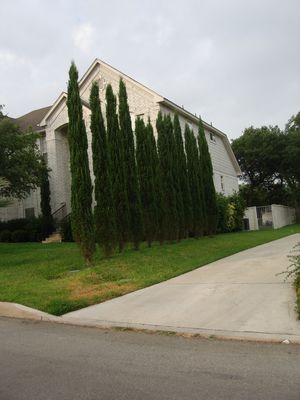Print This Page
Cypress, Italian
Cupressus sempervirens
Italian Cypress stands as an iconic and striking addition to the Texas landscape, offering a host of benefits for gardeners seeking elegance and structure in their outdoor spaces. Renowned for its stately, columnar form, this evergreen conifer provides a vertical accent that adds height and drama to gardens across the state. With its exceptional cold tolerance, Italian Cypress thrives in the diverse climates of Texas, enduring both the intense heat of summer and occasional winter frosts with ease…except for the 2021 freeze which did unfortunately kill many over the state. Its ability to maintain its deep green foliage year-round ensures a constant source of color and texture in the landscape, enhancing the visual appeal of gardens, parks, and urban spaces alike.
Italian Cypress prefers well-draining soils with a slightly acidic to neutral pH level, though it can tolerate a range of soil types commonly found in Texas, including sandy loams and clay soils. This adaptability to varying soil conditions makes it a versatile choice for landscaping projects throughout the state, from coastal regions to inland areas. Its ability to withstand periods of drought once established further enhances its suitability for water-conscious gardeners in Texas, contributing to sustainable landscape practices and water conservation efforts.
Its dense foliage provides privacy, noise reduction, and wind protection, making it particularly well-suited for urban and suburban landscapes in Texas. With its cold tolerance, adaptable soil preferences, and versatility in pruning, Italian Cypress stands as an enduring and timeless choice for enhancing the beauty and functionality of gardens throughout the Lone Star State.
 |
Columnar Tree |
|
|
 |
Height:40 Feet
|
 |
Spread:7 Feet
|
 |
|
USDA Hardiness Zone 7b
Available Sizes:
| Item |
Description |
| CYP-ITA-05 |
#005 CYPRESS, ITALIAN |

|
| CYP-ITA-15 |
#015 CYPRESS, ITALIAN |
|
| CYP-ITA-30 |
#030 CYPRESS, ITALIAN |

|
Characteristics & Attributes
|
Deer Tolerance
|
Exposure
|
Habit
|
Soil pH Preference
|
|
Water Needs
|
Toxic to Pets
| • |
Branches |
| • |
Roots |
| • |
Leaves |
|






